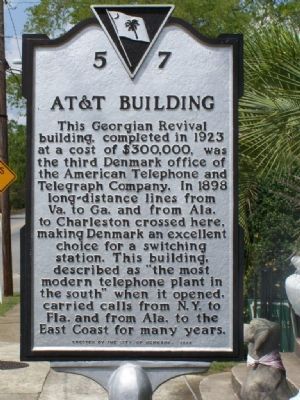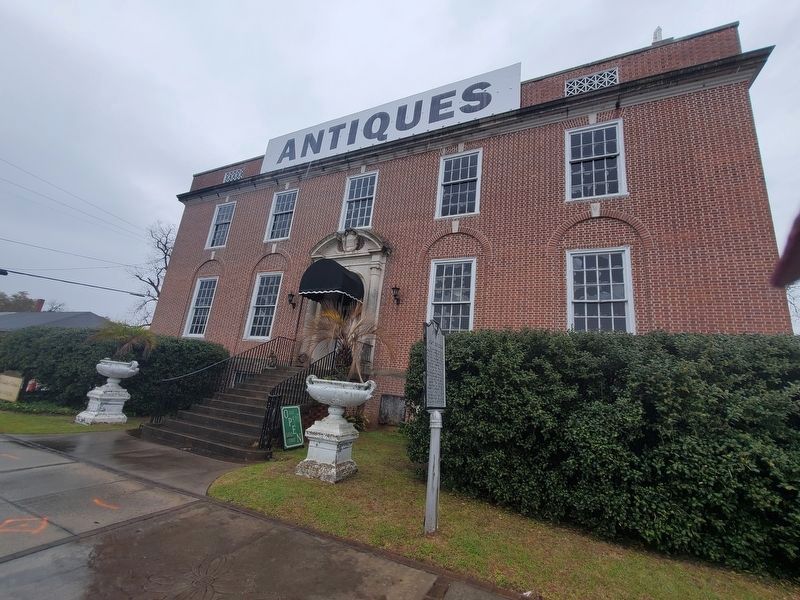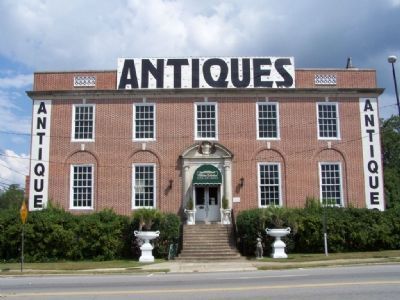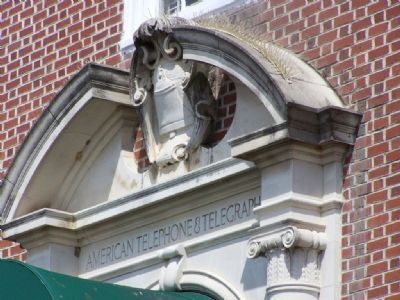Denmark in Bamberg County, South Carolina — The American South (South Atlantic)
AT&T Building
Erected 1999 by City of Denmark. (Marker Number 5-7.)
Topics and series. This historical marker is listed in these topic lists: Architecture • Communications • Industry & Commerce. In addition, it is included in the National Historic Landmarks series list. A significant historical year for this entry is 1923.
Location. 33° 19.27′ N, 81° 8.537′ W. Marker is in Denmark, South Carolina, in Bamberg County. Marker is on Carolina Highway (U.S. 321), on the right when traveling north. Touch for map. Marker is in this post office area: Denmark SC 29042, United States of America. Touch for directions.
Other nearby markers. At least 8 other markers are within 7 miles of this marker, measured as the crow flies. Denmark Depot (approx. 0.4 miles away); Denmark High School (approx. 0.4 miles away); Voorhees College (approx. 1.1 miles away); Pinewood Plantation (approx. 3.7 miles away); Holman's Bridge (approx. 5.4 miles away); Salem Methodist Church (approx. 6 miles away); Bamberg County Courthouse (approx. 6.4 miles away); Bamberg County Confederate Monument (approx. 6.4 miles away). Touch for a list and map of all markers in Denmark.
Regarding AT&T Building. During WWII, the AT&T building, and nearby train depot were guarded by soldiers from Fort Stewart, Georgia. This building was an important link in the nation’s communications, and was considered a prime target for sabotage. This historic building is now a home to an antiques store on Carolina Highway, US 321. Kind of fitting for the times.
National Register of Historic Places :
American Telephone and Telegraph Company Building (added 1999 - Building - #99000815) •
Also known as Southern Bell Telephone Building
124 N. Palmetto Ave., Denmark •
♦ Historic Significance: Event,
♦ Architecture/Engineering
Architect, builder, or engineer: Woodward, D.H., Lacy, T.N.
♦ Architectural Style: Colonial Revival
♦ Area of Significance: Communications, Architecture
♦ Period of Significance: 1900-1924, 1925-1949
♦ Owner: Private
♦ Historic Function: Industry/Processing/Extraction
♦ Historic Sub-function: Communications Facility ♦ Current Function: Commerce/Trade
♦ Current Sub-function: Specialty Store
Also see . . .
1. History of Network Switching. “For many years, all long distance calls began with a call to an operator sitting at a toll (long-distance) switchboard. Until the 1920s, that operator wrote down the calling information provided by the customer, and then told the customer that he or she would be called back once the party was on the line. The operator then passed the information to another operator, who would look up the route that the call should take, and then build up the circuit one link at a time by connecting to operators at switchboards along the route. A typical call took seven minutes to set up. Once operators established a circuit, it was dedicated to that conversation until the end of the call.” This building was built when AT&T began improving the handling of long distance calls. (Submitted on December 18, 2007, by J. J. Prats of Powell, Ohio.)
2. American Telephone and Telegraph Company Building,. The American Telephone & Telegraph Company Building is significant not only as an excellent example of early twentieth century corporate architecture in the Georgian Revival style, but also for the role the American Telephone & Telegraph Company played in the development of the telephone and communications industry in early twentieth century lowcountry South Carolina. (Submitted on September 18, 2008, by Brian Scott of Anderson, South Carolina.)
Additional commentary.
1. Long Distance Calls Were Expensive in 1927
The cost of long distance calls that were switched through this building in the 1920s and ’30s varied by distance and could be as high as $20 or more for the first three minutes. Back then the U.S. average monthly salary was just a little over $100. The common man did not make many long distance calls.
— Submitted December 18, 2007, by J. J. Prats of Powell, Ohio.
2. Radio and then Television Broadcasts were Transmitted Through This Building
A few years after this building was first built, the National Broadcasting Company (NBC) had just been formed and used AT&T Long Lines to transmit its programs to local radio stations, creating one of the first radio networks. Columbia Broadcasting System (CBS)
followed in 1928. Begining in the 1950s, network television programs also used AT&T Long Lines to reach local broadcast stations until satellite distribution took over late in the 20th century.
— Submitted December 18, 2007, by J. J. Prats of Powell, Ohio.
3. This Building Was Once Full of Western Electric Equipment
AT&T and the Bell System used its leasing arrangements for telephones and telephone equipment made by its subsidiary, Western Electric to increase its control over telephone manufacturing in the United States and Canada. Western Electric-made phones were owned not by individual customers, but by local Bell System telephone companies — all of which were in turn owned by AT&T, which also owned Western Electric itself. Instead, each phone was leased from AT&T on a monthly basis by customers, who generally paid for their phone and its connection many times over in cumulative lease fees. This monopoly made millions of extra dollars for AT&T and Western Electric, which had the secondary effect of greatly limiting phone choices and styles. Many phones made by Western Electric carried the following disclaimer permanently molded into their housings: “BELL SYSTEM PROPERTY—NOT FOR SALE.” Telephones also labeled with a sticker marking the
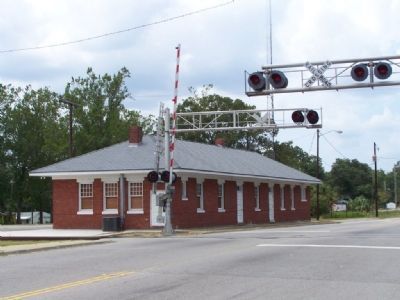
Photographed By Michael Stroud, July 1, 2007
5. The Nearby Former Atlantic Coast Line Train Station
Denmark, South Carolina, in Bamberg county, is 47 miles S of Columbia, South Carolina (center to center) and 132 miles S of Charlotte, North Carolina. As of the year 2000 census, 3,328 people lived in Denmark.
On January 1, 1984, Western Electric Co. was assumed under the corporate charter of the new AT&T Technologies, Inc. Western Electric was then split up into several divisions, each focusing on a particular type of customer (e.g. AT&T Technology Systems, AT&T Network Systems). Telephones made by Western Electric prior to the breakup continued to be manufactured and continued to be marked “Western Electric,” with the Bell logo absent, or hidden by metal filler inside of all telephone housings and most components, including new electronic integrated circuits with the famous “WE” initials.
[After further divestitures and spinoffs late in the 20th century, the remains of the Western Electric division are now named Lucent Technologies and Avaya, Inc.—and no longer under the control of AT&T.]—Ed.
— Submitted December 18, 2007, by Mike Stroud of Bluffton, South Carolina.
Credits. This page was last revised on April 5, 2023. It was originally submitted on December 18, 2007, by Mike Stroud of Bluffton, South Carolina. This page has been viewed 2,926 times since then and 66 times this year. Last updated on June 4, 2009, by Mike Stroud of Bluffton, South Carolina. Photos: 1. submitted on December 18, 2007, by Mike Stroud of Bluffton, South Carolina. 2. submitted on April 4, 2023, by Yvonne Vaughn of Elgin, South Carolina. 3, 4, 5. submitted on December 18, 2007, by Mike Stroud of Bluffton, South Carolina. • Craig Swain was the editor who published this page.
